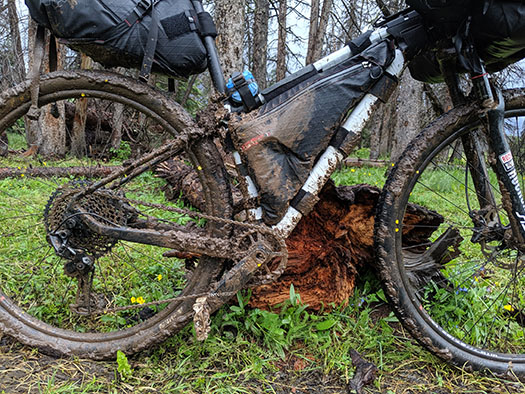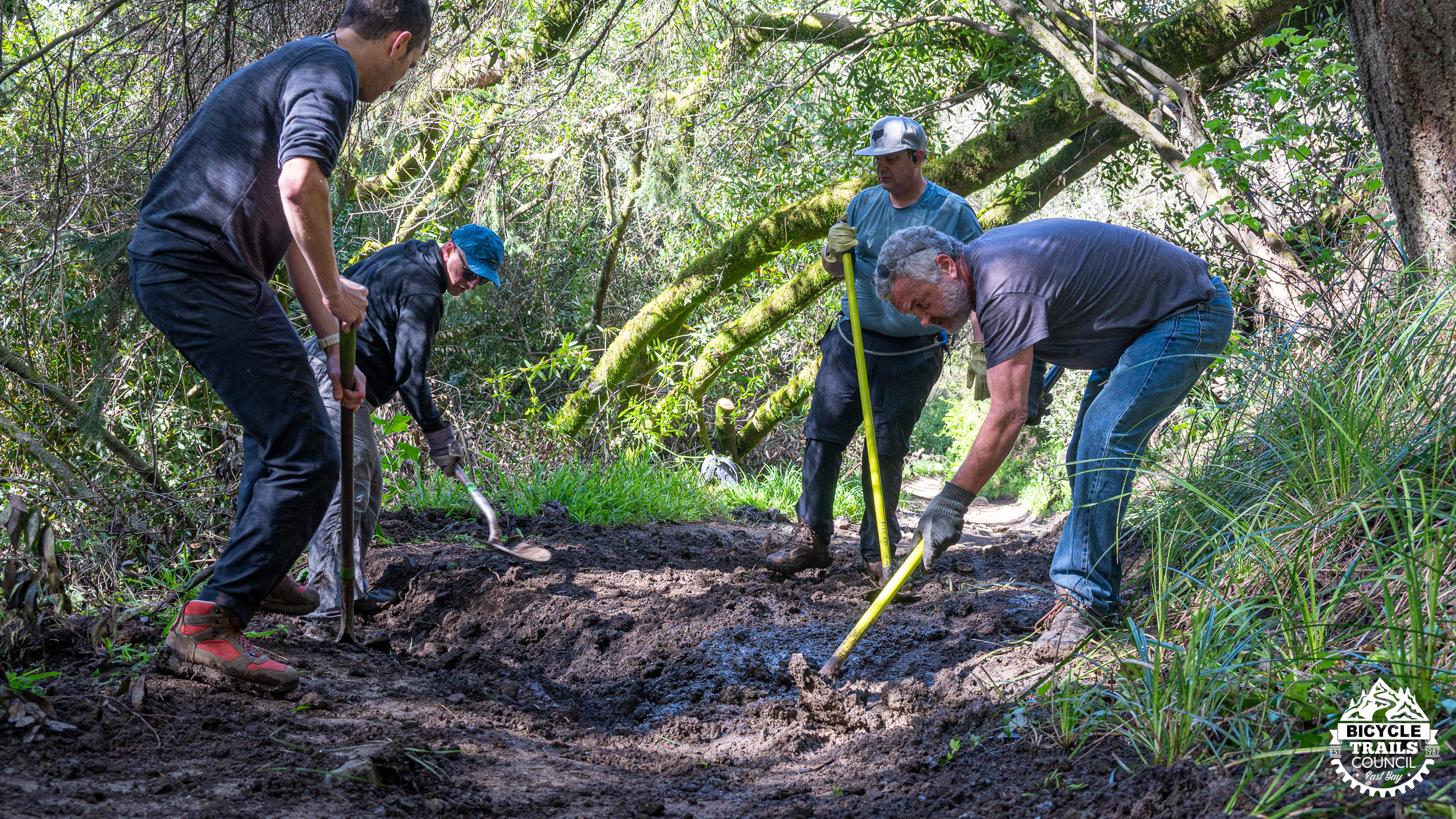by Tom Gandesbery

Are you dreaming about a summer adventure? Maybe even starting to plan one? Then maybe just maybe bike-packing is in your post-COVID future!
Do you long to spend quiet time in the great outdoors? Do you want to travel to distant places and explore other cultures at a speed that is slow enough to move with the butterflies but not so fast as to smash them to smithereens? Do you have days to weeks to spend visiting places of breathtaking beauty while forgoing many of the comforts of a Hilton, a Marriot or a Sandals Resort? (once referred to as “roughing it”) And here is the obvious question: do you want to do that while on your bike? If yes, then you should consider Bikepacking!

Before getting too far into this topic, let me say that this is just a short introduction and rather than try to explain all the facets and intricacies of the pastime / sport / obsession I will just point you to a few excellent resources from which you can do your own research and come to your own conclusions. These various websites and zines are where I have picked up tips and inspiration. (Some links below)
What is it?
So, to define our terms, “bike-packing” is just backpacking on your bike. Simple as that. Is it “new”? Well sort of but not really. Arguably folks have been bikepacking since The Wheel was perfected . . .
And like bike “touring” the rider is self-supported; nobody is carrying your stuff. But related there are many small touring companies that offer to do just that as you ride out each day (see Easing Into It, below).
But how may you ask is it different from regular bike touring? Not very and very much, depending on context. For example, many ‘bikepacking’ trips take place over fairly smooth gravel roads, where a traditional and experienced bike tourist using wider tires might not hesitate to tread. On the other hand, there are well established bikepacking routes like the Arizona Trail (AZT for short) that demand a serious mountain bike (favoring full-suspension) and bike packing gear (not to mention attitude!). A traditional bike tourist would take one look at the AZT and turn around for the comfort of state highways (Ah, crumbling shoulders, broken glass and 18-wheelers). But in most cases, like many of life’s pursuits, bikepacking is a study in compromises: performance vs. reliability. Comfort vs. weight. And not surprising, bikepacking has it’s sub-genre, its spin-offs: fat-bike beach touring, fat-bike snow camping, inflatable raft touring, fly fishing. Imagination is the limit.
If you have done any backpacking, you might ask how is bikepacking different from that? Why not just sling your gear over your shoulder and leave the bike behind? Well for one you will never get those horribly sore hips and shoulders after three days out, since nearly all your gear is on your bike. And depending on your route, you may actually get away with carrying less food and other materials, as you may end up covering anywhere from two to ten times the distance you can cover on foot. That can make resupply points more frequent. So camp for a few days, dash into town for burgers and a warm bed and then head back into the woods for more camping. On the other hand, you will be shutout of riding in our nation’s Wilderness Areas and on trails in National Parks where wheeled machines are not allowed. So don’t toss your backpack quite yet. And in Canada and other countries, the rules are of course very different. But it seems globally the wild country open to bicycle access is limitless.
When first thinking about this new pursuit, it is natural to focus on the bike: what sort is the best? Is my bike going to work? And jeepers, is this an excuse to get a new bike?! Sorry but consensus amongst the bike-packing experts seems to be that “the best bike is the one you have”. In other words, a good mountain bike in good condition is all you need. Not to say that some bikes will work better suited to the type of riding you might expect on a given route. One reason being that when fully loaded your machine should be maneuverable, but it won’t have that liveliness of an unloaded bike. And you won’t likely be pushing yourself to the limit of your technical abilities. An obvious solution can sometimes be had when you make camp, strip the bags off and go shred that perfect single track. Then, after a suitable respite, resume more slog-ish tour.
But what is specific to bikepacking is your luggage. The bags, which you strap, lash and buckle to your bike become the focal point of trip planning, organizing, and obsessing. The challenge is to see what can be fitted where, all the while keeping the center of mass narrow and low. That in a nutshell was the difference between traditional bike touring and bike packing. A touring bike was a 700cm road bike built like a brick house with sturdy racks, maybe fenders and built-in lights, was designed to carry touring bags, called “panniers” (since I guess us Americans could not think of a better description in English), both front and back. With a bazillion cubic inches of capacity, there was nothing keeping one from bringing any and all items that “might come in handy”. Hence, the 100-pound touring rig. (And the BOB trailer – which is 15 pounds empty). Contrast that to the typical bikepacking rig which is a hard-tail mountain bike fitted with a large seat bag, frame bag and some sort duffle bag slung from the handlebars.

There are many variations on the theme, and many arguments going every which way on things like: hydro-packs – love them or hate them?, minimalistic metal racks to keep the bags steady, even wire baskets hanging out front. Yes, the luggage is where folks get very creative and opiniated.
A Very Short History:
It was the late 1980s when a couple of intrepid young adventures set out to ride the Continental Divide (Mexico to Canada) on their new-fangled mountain bikes. They found out that lighter is better (And you will too!). In 1998 the Adventure Cycling Association published maps of a route (see link below) which became popular with those traveling both by bicycle and off-road motorcycle. This thing also grew out of that crazy race up in Alaska called the Iditarod, a dog sled race, that spawned races on same route using touring skies, mountain bikes and then, in the snow, fat bikes. And that lead to some innovative ways to carry gear on a mountain bike by a small Alaskan bag company called Revelate (which I think sounds funny because it sounds like “re-evaluate). Which lead to the bikepacking bags, as we know them today. Once a fairly niche product, you can now buy them from the major makers and REI. And you know something has gone ‘mainstream’ when it’s featured at your local REI! So, the endurance racers can be credited for innovating much of the gear and the approach to using it, not to mention inspiring many thousands of ‘regular folk’ (like me) to take up the sport.

Where to Go?
Bikepacking around the bay area is possible with a few campgrounds located within riding distance. However, most bike packing adventures lean heavily on what is called “dispersed camping” that is pitching your camp just off the trail for the night and leaving no trace the next morning. This is mostly allowed and even encouraged in our national forests and BLM lands but is verboten on our regional parks and open spaces. And on private lands, you best talk to the owner first before throwing down your gear and kicking up your feet. Because much of the Sierra high country is designated Wilderness, the majority of bike packing in California seems to happen in the lower elevation northern Sierra / Cascades and the south eastern parts of the state. There are some newly established routes in Oregon that start just north of the border at Klamath Lake and take you to the far end of the state. You could easily burn two weeks exploring all the trails and dirt roads of the Oregon Cascades (see Resources below). And the Canadian Rockies down to Mexico? That would fill a few books.

Easing into It:
While outside the scope of this article there are ways to ride your bike all day and not have to lug all the [sometimes heavy] camping gear and do all the [often stressful] logistical planning. There is a myriad of small touring companies that do everything from just meet you at the end of the day with your camping gear, to arrange a comfy hut with hot food, cold beer, and showers. And there are also some established hut-to-hut routes in the southwestern region, maybe elsewhere too. (Let Google be your guide!) Some folks do their own supported tour and do a vehicle shuttle, taking turns driving one day while the others ride. Maybe all this can be covered in future issue of the Buzz . . .
Some Bikepacking Resources
Adventure Cycling Association: These are the folks who started it all. Formed from the 1976 “Bike Centennial” the focus was for many years was on cross country touring but as excellent paper maps of a few major routes, is getting it together on digital resources, and also has a ton of supported rides. ACA published the first maps of the “Great Divide Mountain Bike Route” which is now very popular, is raced and utilized by thousands of cyclists and motorcyclists each year. https://www.adventurecycling.org/
Bikepacking dot net: Crowd-sourced = no advertisement, less focus on gear and many, many stories. http://www.bikepacking.net/bikepacking-routes/
Bikepacking Roots: A newish nonprofit with impressive leadership, they are building new routes in the Rockies and southwest to augment what Adventure Cycling Assoc. started with the Great Divide route way back when. https://www.bikepackingroots.org/
Bikepacking.com: As the name implies, a commercial site but one with great stories, route ideas and inspiring photos. Much on south America and Asia. https://bikepacking.com/
The Radavist: This is the glossy fashion mag of cycling. Great photos of quirky bikes and hand-made approaches to gear. Not much bike packing content but some of the articles can be inspiring. (For the record I’m far older than the target demographic, don’t have a beard and own only one flannel shirt) https://theradavist.com/
Adventure Journal: More Eye Candy. Cycling is just a small part of what they cover in this magazine, which is amazing stories of heroic (or stupid you be the judge) endeavors in extreme places. An online zine and a print journal which I thought had gone out of business but apparently not. https://www.adventure-journal.com/category/all-things-bike/
Some Route Specific Resources
Colorado Trail Association: Amazing non-profit that created and maintains the Colorado Trail (which is also the Continental Divide Hiking Trail in CO). Publishes a fantastic guidebook for the trail as well as organizes thousands of volunteers who maintain segments of the trail. https://coloradotrail.org/
Oregon Timber Trail: Newer effort now with apparent challenges of wildfire impacts. Can we ride much this route now? On my short list: https://oregontimbertrail.org/
Oregon Bike Packing: BTW These new routes help tourism in some very remote towns. http://www.oregonbikepacking.com/
Arizona Trail: https://aztrail.org/explore/mountain-bikers/
And about those first bike-packers
The Buffalo Soldiers Who Rode Bikes





